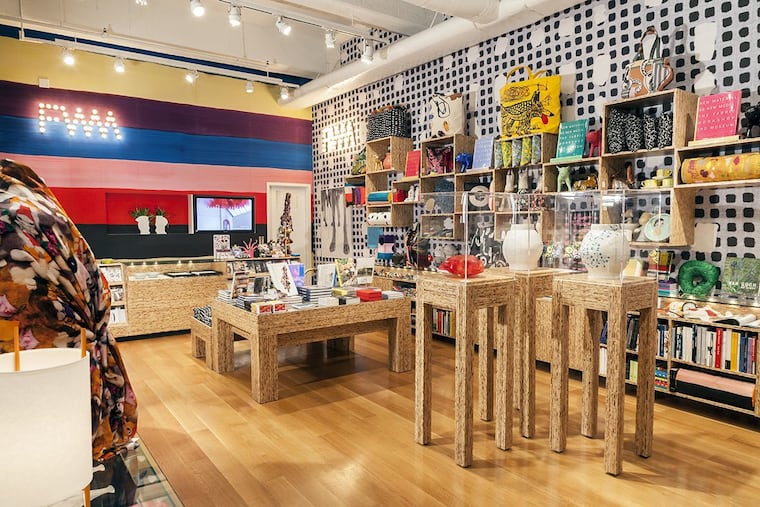Could gift sales be Philly museums’ last best hope for a revenue bump in this devastating year?
Retail sales — largely online — have proven to be a relatively sturdy source of revenue for most pandemic-burdened museums. Look for a new pop-up shop at the Philadelphia Museum of Art this week.

It has not been the greatest year for the National Museum of American Jewish History on Independence Mall.
First came bankruptcy, followed by pandemic, layoffs, and temporary closure. But then President Donald Trump brought forth a gift.
Lauding national parks at a White House event this summer, Trump said the eyes of young Americans “widen in amazement” when “they gaze upon Yo Semites, Yo Seminite’s towering sequoias.”
The internet went wild over the Yosemite National Park gaffe. And Kristen Kreider, the museum’s retail director, seized the moment. Since 2011, the museum had stocked a camping T-shirt emblazoned with “Yo Semite” beneath a couple of pine trees.
“I thought, ‘Oh my God, this is gonna be crazy,’ ” Kreider recalled. It was.
“People were tweeting it, Washington correspondents were tweeting it, White House correspondents, a New York Times columnist, the Lincoln Project tweeted it. It just gathered so much momentum, and we were the only place you could get it.”
Within a day or two, 6,000 shirts were out the door. The museum added a Philadelphia source for printing them.
“The printing company had to bring back a bunch of furloughed employees,” said Kreider. “It was really kind of a great thing.”
Some shelter in the storm
Although the Jewish museum’s wild viral moment is unique, retail sales — largely online — have proven to be a relatively sturdy source of revenue for most pandemic-burdened museums.
Those institutions that have reopened following coronavirus shutdowns (the Jewish museum has not), report retail as something of a bright spot. Meanwhile, with museum visitors nowhere near pre-pandemic levels, the internet has made it possible for retail to prop up sagging revenue, leading institutions to beef up their websites.
The Philadelphia Museum of Art is now putting the finishing touches on a new pop-up retail shop, located in the special exhibition galleries off the Great Stair Hall, to open beginning this Friday and into the middle of January.
The work of Philadelphia-based artists will be offered in the new space to help support those who are struggling, said Christine Doobinin, who heads museum retail operations. The museum has also revamped its website in an effort to boost online sales.
The Philadelphia Museum of Art Craft Show, an annual fund-raiser independently operated by the Women’s Committee of the museum, will go completely virtual this year, a first. The Craft Show, running Friday through Sunday, features the work of 150 artists along with talks and demonstrations.
In the past, the show has raised as much as $400,000 in a year for museum programs and craft acquisitions. Over 43 years, it has raised $13.4 million. What are the expectations for the virtual event?
“In a year that is like no other, we don’t know exactly what to expect,” said Nancy O’Meara, PMA Craft Show manager, although their hope is to expand the audience "through being accessible to anyone across the country.”
Christmas comes early online at the Brandywine
The Brandywine River Museum has enhanced its digital retail effort, most noticeably with the expansion of its annual holiday sale of “Brandywine Critters,” animals made by local volunteers that have been sold by the museum to the public for 35 years.
“They’re made from all natural materials — pine cones, seed pods, acorns, berries,” said Brandywine spokeswoman Nicole Kindbeiter, a museum spokesperson. Over the course of their existence, the critters have raised about $1.3 million for the acquisitions and education programming.
This year the physical sale takes place Dec. 2-6, but online sales are already up and running.
Kindbeiter said the museum is “meeting or exceeding its goals for shop sales, and for online sales in particular.”
Downtime to revamp retail
The same is true for the Fabric Workshop and Museum.
Christina Vassallo, head of FWM, said the pandemic closure allowed the museum to spend the time revamping its website, tying retail offerings even more closely with FWM artists. The result is that retail revenue at the reopened museum is now projected to be “a little bit higher than in the past” as a percentage of operating income.
At the Museum of the American Revolution, neither online nor in-museum sales are up — museum attendance is down about 85% — but more people who visit now buy something at the store, where the average sale is up from $27 to $36.
The Penn Museum relied on its Facebook and Instagram sites for online sales throughout the period of pandemic closure from March until July. That is about to change, said Melissa Smith, deputy director of museum operations.
She said the museum is planning a new retail-friendly website which should be up and running before the holidays. At this point, museum gift shop sales are at about 54% of last year, with museum attendance at about 38% for the same period, Smith said.
The Princeton University Art Museum is closed entirely. But the museum has recently retooled its website to promote online sales.
Along with most area museums, it will participate in “Museum Store Sunday,” Nov. 29, a one-day worldwide promotional event.
Like the Philadelphia Museum of Art pop-up, the Princeton effort supports local artists, said Gabrielle Langholtz, a Princeton Art Museum spokeswoman, and brings “beautiful handmade things into your life.”